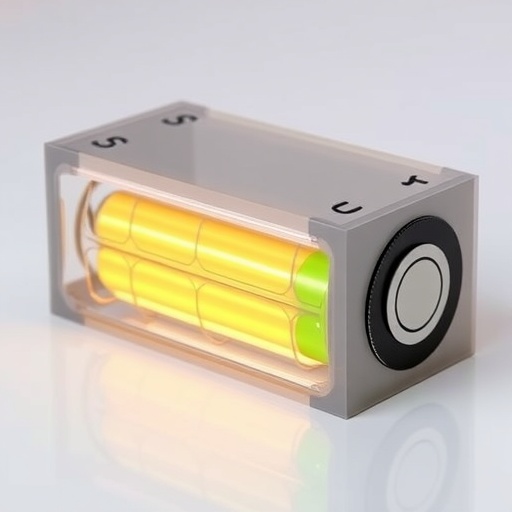Researchers are continually seeking advanced materials to enhance the performance of sodium-ion batteries, a crucial technology for sustainable energy storage. In a groundbreaking study by Hou, Yan, Zhang, and their colleagues, a novel approach involving synergistic carbon composite and heterostructure engineering in the composite material Zn0.8Co0.2S/Co8NiS8 has been explored. The authors assert that this engineering framework marks a significant milestone in the pursuit of high-performance sodium storage solutions.
At the heart of this research is the integration of diverse materials, specifically Zn0.8Co0.2S and Co8NiS8, into an innovative composite structure. The authors emphasize the potential of these materials when combined effectively, showcasing their synergistic properties that significantly enhance battery performance. The novel composite not only improves the electrochemical efficiency but also provides a remarkable capacity for sodium ions, which is critical for reliable energy storage applications.
The study underscores the advantages of heterostructure engineering in material design. In heterostructures, the geometric arrangement of different materials can foster unique properties, promoting enhanced charge transport mechanisms. This study leverages these principles to create a stable and efficient interface between the Zn0.8Co0.2S and Co8NiS8 components. The authors detail how these material interactions result in lower impedance and superior cycling stability, which are essential characteristics for any high-capacity battery technology.
Analysis conducted in the study focuses on the electrochemical behavior of the developed composite under various conditions. Researchers employed sophisticated techniques such as galvanostatic charge-discharge tests, electrochemical impedance spectroscopy, and cyclic voltammetry to glean insights into the composite’s performance. These analyses demonstrate that the Zn0.8Co0.2S/Co8NiS8 composite achieves high reversible capacities and exhibits impressive rate capabilities, crucial for real-world application in sodium-ion batteries.
One of the standout results from this study is the material’s remarkable cycling stability. The authors report that the composite can retain a significant percentage of its initial capacity even after numerous charge-discharge cycles. This longevity is imperative for the commercial viability of sodium-ion batteries, which often face limitations due to cycling degradation in conventional materials. Their findings suggest that the synergistic effects present in the engineered composite play a pivotal role in prolonging its lifespan and reliability.
Additionally, the research outlines the importance of understanding the interfacial phenomena occurring within the composite structure. The authors hypothesize that the optimized interactions between Zn0.8Co0.2S and Co8NiS8 facilitate effective sodium ion diffusion and electron transport. This enhanced transport contributes to the overall efficiency of the sodium storage process and is indicative of the future potential for this approach in energy storage solutions.
Moreover, the environmental considerations regarding sodium-ion batteries are discussed in the context of this work. As the world moves towards sustainable energy solutions, sodium-based technologies are gaining traction due to the abundant availability of sodium compared to lithium. The findings discussed suggest that utilizing Zn0.8Co0.2S/Co8NiS8 composites could pave the way for developing environmentally friendly batteries that can meet global energy demands without depleting limited resources.
The implications of such innovations extend beyond mere performance metrics. The fundamental insights provided by this work could inspire the next generations of energy storage technologies. The ability to manipulate the microstructural properties of materials enables scientists and engineers to tailor batteries for specific applications, such as electric vehicles and grid storage. By advancing our understanding of these composites, researchers can contribute to building a sustainable future.
In concluding their research, the authors advocate for further exploration into other potential combinations of materials to push the boundaries of sodium-ion battery technology. They highlight the need for interdisciplinary collaboration to fully realize the potential benefits of such engineered materials in energy storage systems. This pioneering study lays a robust foundation for future advancements and emphasizes the critical role of material science in solving energy challenges of the modern age.
As the research community reflects on these findings, it becomes apparent that the work of Hou and his colleagues represents a significant step towards innovation in energy storage processes. The rigorous methodological approach, combined with insightful analysis, showcases the potential of combining different materials to create high-performance energy storage systems. The progress made through this research could prove transformative in shaping the landscape of battery technology and addressing the urgent need for sustainable energy sources.
In summary, the engineering of a carbon composite and heterostructure framework within the Zn0.8Co0.2S/Co8NiS8 composite presents an exciting avenue in the pursuit of enhanced sodium-ion battery performance. With a solid foundation established through this research, the future of sodium-ion battery technology looks promising, driven by innovative material designs and the quest for efficiency in energy storage solutions.
Subject of Research: Synergistic carbon composite and heterostructure engineering in sodium-ion batteries.
Article Title: Synergistic carbon composite and heterostructure engineering in Zn0.8Co0.2S/Co8NiS8 for high-performance sodium storage in sodium-ion batteries.
Article References:
Hou, Wy., Yan, Hy., Zhang, Xl. et al. Synergistic carbon composite and heterostructure engineering in Zn0.8Co0.2S/Co8NiS8 for high-performance sodium storage in sodium-ion batteries. Ionics (2025). https://doi.org/10.1007/s11581-025-06712-4
Image Credits: AI Generated
DOI: https://doi.org/10.1007/s11581-025-06712-4
Keywords: Sodium-ion batteries, carbon composites, heterostructure engineering, high-performance storage, electrochemical analysis.




